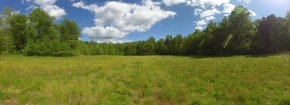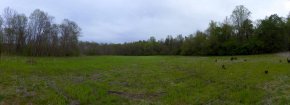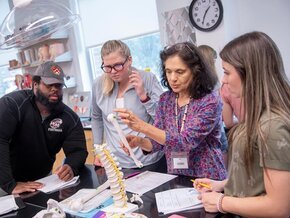
Field of hope and art

When summarizing assistant art professor Claire Pope, MFA most recent project, it would appear to be a study of cause and effect – but that would be leaving out the wonder.
In 2020, Pope’s artist residency in Scotland was postponed due to COVID travel restrictions. As a result of the lockdown and people not traveling as frequently, daily fossil fuel emissions declined. Pope, whose art has always incorporated the environment, was fascinated by this effect. In tandem with Robin Wall Kimmerer’s book Braiding Sweetgrass, which she’d picked up to read the same year, an idea began to grow for Pope.
“This was stepping out of my comfort zone,” explained Pope. “I have always used natural matter to create artwork, but I was excited to do a community art project. One that can’t be quantified, that’s not intended to make money, but instead intends to create awareness.”
Introducing: The Meadow Project
Hidden within the 652 acres of the Oak Hill Community Park and Forest in Morganton, North Carolina lies a 3-acre field previously damaged by agricultural overuse. In partnership with Foothills Conservancy of North Carolina, and funded in part by the North Carolina Arts Council, The Meadow Project is a six-month documentation of the field led by Pope.

With the use of a professional solar-powered timelapse panoramic camera, photos are captured every 10 minutes. They are then compiled into timelapse videos, which are shared on www.clairelpope.com where anyone with Wi-Fi access can view them. To Pope’s surprise and delight, since starting the project in February, The Meadow Project has attracted followers from all over the world including Australia, South America, China, and Europe.
Approaching the project from a scientific viewpoint, Pope is exploring a few avenues in terms of a hypothesis. Can Nature heal itself? What happens when we simply step out of the way? Can we slow down as a society as a means of honoring and building a more reciprocal relationship with the natural world. But her approach is also one of optimism.
“My hope is that it would communicate hope,” Pope said of the land that has had no human interaction since the project begin. “That if we slow down, and step out of the way, and allow nature to do what it can, that some of these daunting environmental issues that are life-changing could actually be healed or begin to heal.”
Documenting Hope
Followers of The Meadow Project have witnessed revitalization of the field — real-life illustrated answers to Pope’s big questions.
These captivating images show a range of new growth of clovers, mulleins, volunteer trees, and grasses. In one photo, which Pope entitled “The Dinner Party,” a herd of deer munch on the meadow next to a flock of turkey.
“That, to me, was such a delight,” Pope said, smiling. “To see this field that was totally devastated come to life and be not only nourishing, but a place of community for the animals.”

Drawing inspiration from her work in the meadow, Pope is in the process of planning a project exhibit featuring a short film of the timelapse videos and art pieces with sustainably sourced materials from the field. One of the pieces uses rolled-up birch bark to represent a message from nature, inspiring the question, ‘If the natural world could send us a message, what would it be?’
Creation Leads to Learning
As an artist and educator, Pope has put thought into the learning opportunities The Meadow Project can provide to students. During the 2022 spring semester, she incorporated project discussion into the curriculum, and she aspires to offer workshops, gallery talks, or reading groups to further audience engagement once the exhibit opens. Future opportunities for her students and the greater Lenoir-Rhyne community to be involved with Foothills Conservancy are a priority for Pope.

But her students are not the only ones learning from The Meadow Project. In the same way she gathers materials for her art, the artist herself harvests bits of wisdom from the process of watching the timelapse of the field. The greatest of these has been realizing that the camera is not just capturing growth, but the passing of time.
“I think that’s something that we can all relate to, and that’s something that connects us and reminds us that we’re not a separate entity from nature,” Pope explained. “We’re all experiencing time. That bond is really what I’m getting at.”

Community members are invited to a free morning of music, reflection and a Freedom Rides-inspired choral production, followed by a Unity March through Hickory.
View More
Lenoir-Rhyne has launched its new strategic plan, "Shine Ever Brighter," an aspirational roadmap designed to strengthen the university’s mission, enhance the student experience and position LR for long-term success in a rapidly evolving higher education landscape.
View More